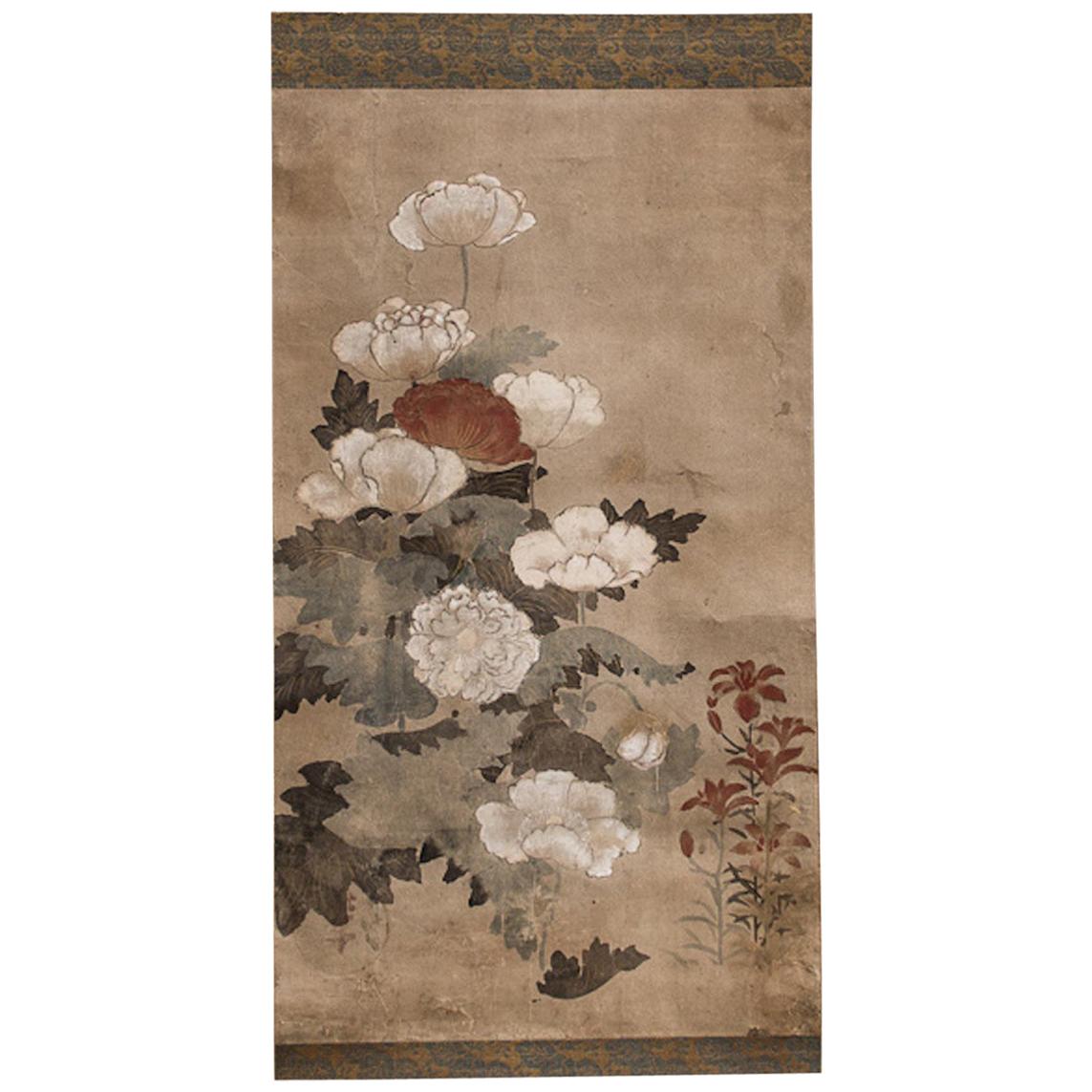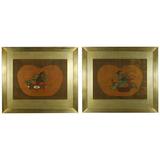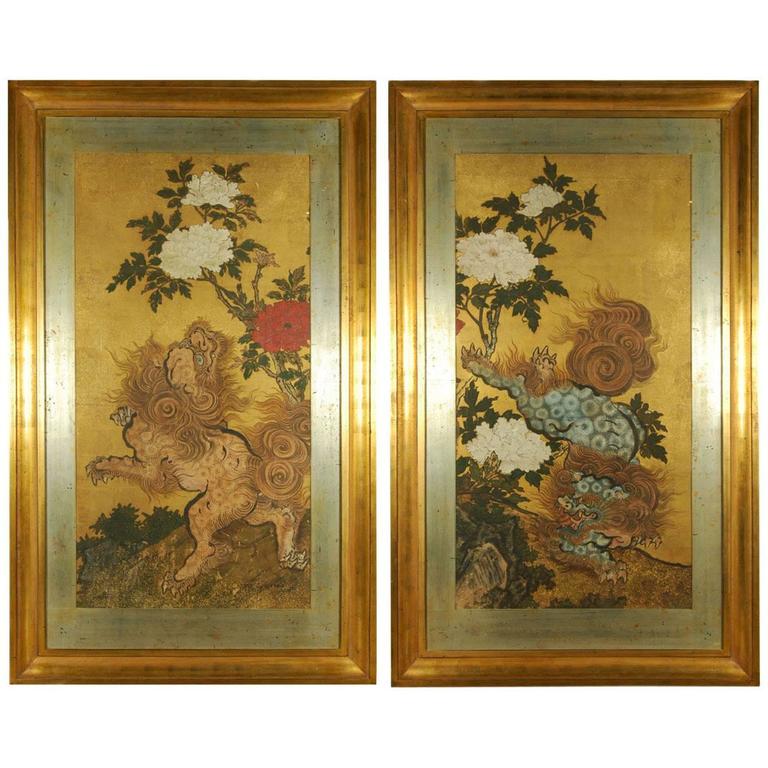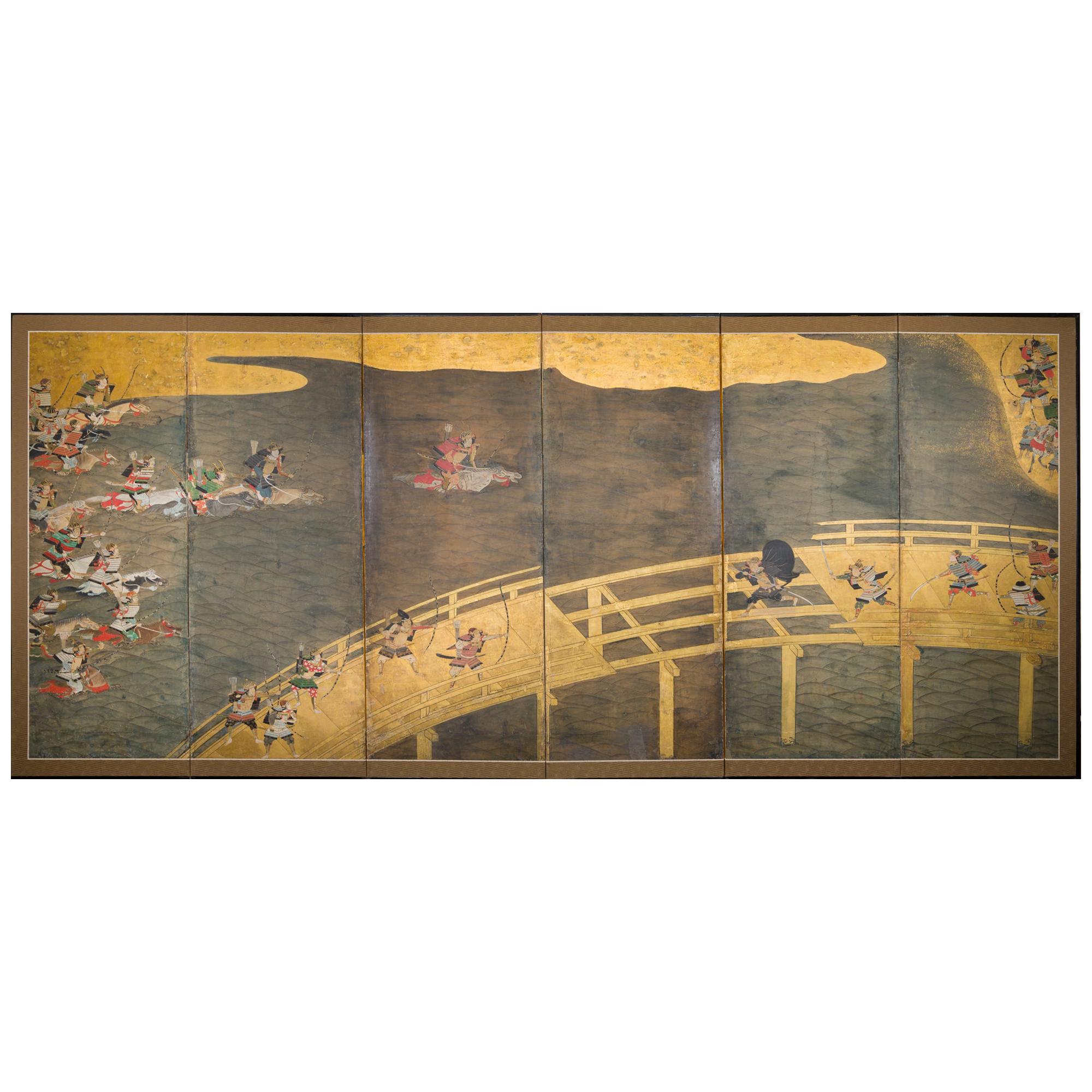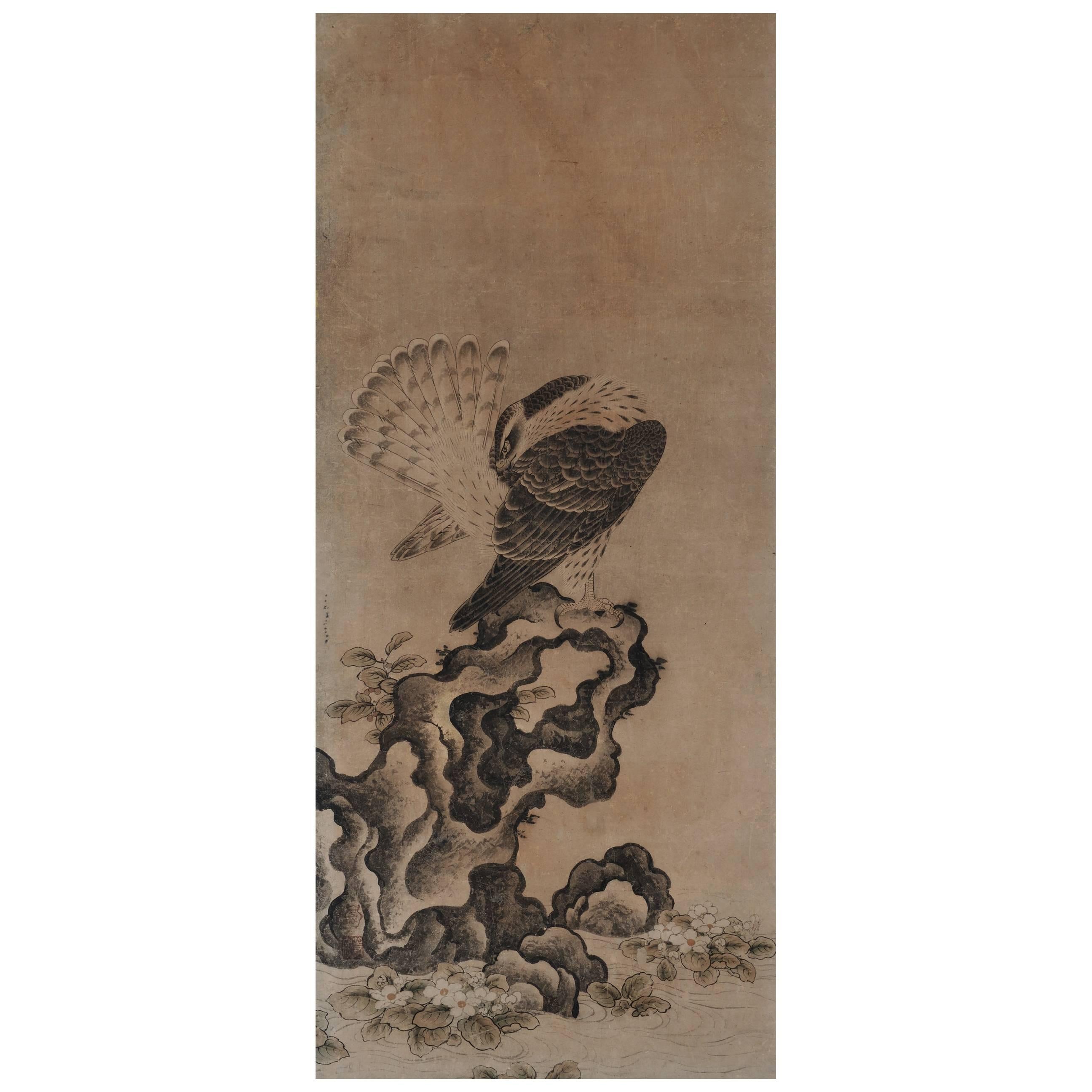Items Similar to Late 18th Century Japanese Framed Painting, God of Thunder by Yamaguchi Soken
Want more images or videos?
Request additional images or videos from the seller
1 of 6
Late 18th Century Japanese Framed Painting, God of Thunder by Yamaguchi Soken
About the Item
Raijin - God of Thunder
Yamaguchi Soken (1759-1818)
Mid to Late Edo period, circa 1800.
Framed painting. Ink and light color on paper.
This humorous painting depicts the Thunder God, Raijin, tumbling from the sky, presumably being struck down by one of his own lighting bolts. He clings to one drumstick as the other is in free-fall along with his Taiko drums, which he was using to whip up the storm. For its time, Soken’s version is unique. Compared to the series of colorful, decorative images of Wind and Thunder Gods that were first painted by Tawaraya Sotatsu and followed by later Rinpa artists, Soken’s painting is a mischievous and dynamic work. Soken is known to have influenced the famous Meiji period artist Kawanabe Kyosai, and several paintings of Wind and Thunder Gods by him survive, most with an underlying humor. Mano Gyotei was in turn influenced by Kawanabe Kyosai and the subject matter and its underlying humor and rich expression became a favored subject matter of his.
Yamaguchi Soken was known as one of the ten great disciples of Maruyama Okyo. He specialized in pictures of women and genre scenes, many of which represent the life and customs of Kyoto in a light and witty manner. He was also actively involved in publishing illustrated books, especially painting albums. His works are held in many Japanese and international museums.
- Dimensions:Height: 45.5 in (115.57 cm)Width: 22.5 in (57.15 cm)Depth: 0.75 in (1.91 cm)
- Style:Edo (Of the Period)
- Materials and Techniques:
- Place of Origin:
- Period:
- Date of Manufacture:circa 1800
- Condition:Refinished. Wear consistent with age and use. The painting is mounted on a panel, the frame of roiro mirror-polished, black lacquer. Conservation, mounting and framing was carried out in Kyoto utilizing traditional techniques and craftsmen.
- Seller Location:Kyoto, JP
- Reference Number:1stDibs: LU2472323231052
About the Seller
5.0
Recognized Seller
These prestigious sellers are industry leaders and represent the highest echelon for item quality and design.
Gold Seller
These expertly vetted sellers are highly rated and consistently exceed customer expectations.
Established in 2001
1stDibs seller since 2016
59 sales on 1stDibs
Typical response time: 5 hours
- ShippingRetrieving quote...Ships From: Kyoto, Japan
- Return PolicyA return for this item may be initiated within 10 days of delivery.
More From This SellerView All
- 18th Century Japanese Floral Paintings, Set of 5, Mineral Pigments on Gold LeafLocated in Kyoto, JPA set of 5 Japanese floral paintings from the 18th century. Each painted with mineral pigments directly applied to gold leaf. They were originally designed to be mounted on the leave...Category
Antique Mid-18th Century Japanese Edo Paintings and Screens
MaterialsGold Leaf
- Japanese Painting, Framed Panel, 17th Century Falcon by Mitani ToshukuBy Mitani ToshukuLocated in Kyoto, JPMitani Toshuku (1577-1654) “Falcon” Wall panel, ink and light color on paper. Upper seal: Mitani Lower seal: Toshuku Dimensions: Each 118.5 cm x 51 cm x 2 cm (46.5” x 20” x .75”) Individual falcon paintings by Mitani Toshuku (1577-1654), an early artist of the Unkoku School. Founded by Unkoku Togan (1547–1618), a master of the Momoyama period, the Unkoku school enjoyed long lasting patronage in southern Japan. Togan was a retainer of the Mori family in present day Yamaguchi prefecture. Members of the school considered themselves to be in the artistic lineage of Sesshu Toyo...Category
Antique Early 17th Century Japanese Edo Paintings and Screens
MaterialsWood, Paper
- 17th Century Japanese Framed Painting by Kano Sansetsu, Plum Blossoms in SnowLocated in Kyoto, JPKano Sansetsu (1589-1651) Plum blossoms in snow Edo period, circa 1640 Framed painting. Ink on paper. Kano Sansetsu is a Japanese painter who...Category
Antique 17th Century Japanese Edo Paintings and Screens
MaterialsPaper
- Mid-18th Century Japanese Screen Pair, One Hundred Flowers, ChrysanthemumsLocated in Kyoto, JPOmori Soun (b. 1704) Chrysanthemums - One Hundred Flowers A Pair of Six-fold Japanese Screens. Ink, color, gofun and gold leaf on paper. Dating ...Category
Antique Mid-18th Century Japanese Edo Paintings and Screens
MaterialsGold Leaf
- Japanese Painting, 17th Century, Tale of Genji, Tosa SchoolLocated in Kyoto, JPIllustration to an unidentified chapter of the Tale of Genji (Genji Monogatari) Tosa School (second half of the 17th Century) Ink, pigment, gofun and...Category
Antique Late 17th Century Japanese Edo Paintings and Screens
MaterialsGold Leaf
- Japanese Painting, 17th Century, Tale of Genji, Fujibakama, Tosa SchoolLocated in Kyoto, JPPurple Trousers (Fujibakama), Illustration to Chapter 30 of the Tale of Genji (Genji Monogatari) Tosa School (second half of the 17th century) Ink, ...Category
Antique Late 17th Century Japanese Edo Paintings and Screens
MaterialsGold Leaf
You May Also Like
- 18th Century Japanese Scroll of PoppiesLocated in Hudson, NY18th century Japanese scroll of poppies. Edo Period (early 18th century) Japanese painting of poppies with lilies in the background. Seal on the lower...Category
Antique Early 18th Century Japanese Edo Paintings and Screens
MaterialsSilk, Paper
- Pair of Antique Japanese Flower Paintings by Yanagisawa Kien, circa 18th CenturyBy Yanagisawa KienLocated in Prahran, VictoriaPair of antique Japanese Nagasaki School paintings by Yanagisawa Kien (1704-1758), depicting classical ikebana flower arrangements. Each painted on silk in mineral pigments and beari...Category
Antique Mid-18th Century Japanese Edo Paintings and Screens
MaterialsSilk
- Pair of Antique Japanese Paintings of Karashishi, Edo Period, 18th CenturyLocated in Prahran, VictoriaA rare pair of antique Japanese Karashishi paintings in a landscape of rocks and peony flowers on gold leaf ground in fine handmade frames, Edo period, early 18th century. The Karash...Category
Antique Early 18th Century Japanese Edo Paintings and Screens
MaterialsGold Leaf
- Late 17th-Early 18th Century Japanese Six-Panel Screen, Battle at Uji BridgeLocated in Hudson, NYJapanese six-panel screen: Battle at Uji Bridge, the first battle at Uji was in 1180 and it marked the start of the Heike Wars. The Genji troops crossed the...Category
Antique Late 17th Century Japanese Edo Paintings and Screens
MaterialsGold Leaf
- Chinese Late 18th Century Reverse Painting on Glass in its Original FrameLocated in Hudson, NYThis large reverse painting on glass from China circa 1780 to 1790 depicts a dramatic battle scene of numerous horsemen and infantry charging in a very...Category
Antique Late 18th Century Chinese Paintings and Screens
MaterialsGlass
- 18th Century Japanese Two-Panel Screen Collection of Fans on GoldLocated in Hudson, NY18th century Japanese Screen of a Collection of Fans. Paintings on fans depict famous Japanese painting subjects, this screen was most li...Category
Antique 18th Century Japanese Edo Paintings and Screens
MaterialsGold Leaf
Recently Viewed
View AllMore Ways To Browse
Antique God
Hand Of God
Antique Pictures And Frames
Pictures Of Antique Frames
Mid Century Asian Light
18th Century Women
Antique Decorative Screens
Mid Century Asian Influence
Mid Century Album
Edo Period Paintings
Lighting Bolt
Meiji Framed
Asian God
Antique Wind Up
Asian Drums
Wind Screen
Japanese Screen Kyoto
Edo Frames
